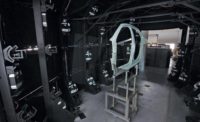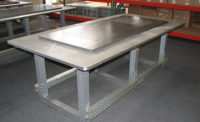Let’s see a show of hands. Does everyone here know what modular tooling/fixturing is by now? If yes, are you an advocate yet? If no, why not? Still think it’s not good enough? Just Tinker Toy, Erector Set or Legos? Well, think again.
It’s still relatively new technology but fast gaining popular use with a positive effect on today’s fixturing options. No longer are the traditional methods required or demanded and here’s why.
First, are the three E’s: Ergonomics, Economics, Ecological—the basics. Overwhelmingly, these benefits have been overlooked with little or no consideration of the “people” part of the equation. Ergonomically, your ideas and safety concerns using simple assembly tools to construct a fixture makes it easy on the hands and mind. Economically, that’s a no brainer: buy it once and use it repeatedly with changes in an instant, almost forever. Ecological aspects have never been so present and necessary as today that the evolution of this technology can easily be compared to no longer cutting down trees to save paper with an end result of a computer to write on and mail over the airwaves. Key words here are the three R’s: reusable, recyclable, reclaimable.
Most fixture kits are aluminum which is one of the largest elements found on earth. For years, and to this day, traditional fixture methods utilize steel structures as a primary component. They also require design and then a step by step manufacturing process that goes a little like this. First, prepare the steel by cutting to size for the “frame.” Set up the steel components, weld them in place and smooth out the rough spot welding so they look good when painted. Normalize the steel frame and make sure it’s as accurate as possible. Hang the locators, clamps, etc., check it again for accuracy. Next, adjust and remount the locators or PLP (Part Location Points), details, nets or other attributes that need to be affixed to the frame. You get the picture. In about a week or so you are ready to use a fixture, maybe. Engineering just told you there’s a major design change and you get to do everything all over again.
At this point, you have many hours, maybe days into the basic structure with a locator scheme provided by the design team with new part data CAD files with the latest revision. The return on investment (ROI) for building a modular tool with half the man hours (or woman hours) to get to this point provides changes “in process” that can be removed and replaced on site or off site as needed. Just tweak the locators and plug them in. Guys upstairs are happy people.
Second, it’s personal, quick, easy and fun so the time and cost savings are elementary. No two fixture builders will make the same fixture with the same components for the same project. Having the right components eliminates the wrong way. Every application has limits. The modularity will accommodate multiple projects every time over and over, again saving money and making the ROI clear to the guys upstairs. Some users are still making adjustments to fixtures purchased ten-plus years ago. And those kit users just keep adding more components to their budgets and wish lists.
Applications
Let’s look at some of the industries that have embraced, integrated and saved over the last 20 years or so.
Automotive has utilized from “art to part” to final inspection. Modular tooling has been used nearly worldwide in some application or another. Design needs it for creating armatures for clay studios. Stamping needs it for checking fixtures in some cases combining with traditional methods for large or small parts. Plastics are a huge part of the automotive interiors for color matching and fit/finish are a must and modular fixtures are lightweight, easy to handle used in hand apply gaging. It’s portable within all sectors of manufacturing.
A recent large U.S. automotive manufacturer using modular tooling has accomplished all these features adapting tool requirements for moving tools into a measurement cell for a noncontact system. The goal was to save time, cost and utilize the same “frame” to accommodate multiple stampings for multiple vehicles. The material needed to “disappear” so the scanner could see only the parts. A win-win situation and the tools are portable and when they need a next generation it is easily converted.
In aerospace/aircraft, these guys call it “cradle to grave” or worse. When a rocket launch is critical and time is of the essence, whether it’s for commercial satellite payloads or for classified USAF, Navy or other government needs, including research and development, the useful option of making fixtures “on the fly” (no pun intended) can be critical. This technology was not always accepted but has been learned by existing fixture building teams to prevent job eliminations and save in areas where labor costs have threatened the consideration of implementing offshore manufacturing. Old dogs can learn new tricks and do it well and pass it on to the next generation.
Manufacturing is a global affair now and so much of the final product is dependent on a team of people all on the same page. Modular tooling components can do this with little or no effort on a single team leader to make a decision to “do it this way” and get everyone involved in the process. That makes people feel good, needed and required. Robots like the modular systems too so it’s simply a good partnership when needed.
When that old trusted outsource is running late, over budget or your underfunded or antiquated internal fixture department can’t get the job done, try modular. Be creative, think modular.






